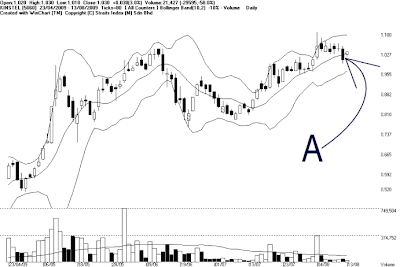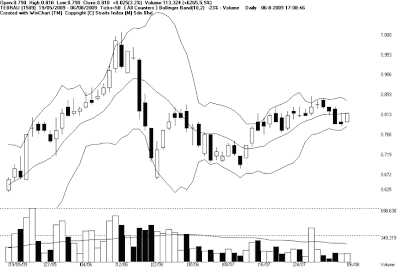
Chart 1: FBM KLCI, chart from 30/04/2009 to 20/08/2009.
As shown on Chart 1, the FBM KLCI Bollinger Bands Width finally re-expanded after contracted for 3 weeks, this suggests that the KLCI has ended its consolidation, and has begun its new movement. Unfortunately, the KLCI is now below the Bollinger Middle Band, and therefore, the immediate outlook is on the negative side. Meanwhile, the narrower the Bollinger Bands Width, the clearer the expansion signal (refer to chart 2), and therefore, the signal of the Bollinger Bands Width re-expansion confirmed the KLCI new movement.

Chart 2: FBMKLCI chart fom 2/09/2004 to 30/11/2009.
As indicated by A, the Bollinger Bands Width was very narrow, and when it re-expanded, the signal is much clearer. The re-expansion of the Bollinger Bands Width as pointed by A, with the KLCI above the Bollinger Middle Band, suggests that the consolidation has ended, and the KLCI started a new uptrend.
After cutting loss, It is perfectly alright to re-enter if the signals are positive:
Many investors are reluctant to cut losses because they are so afraid that the stock price might rebound after they had cut loss. In reality, when chart shows good signal, it makes perfect sense to re-enter as though you were buying a new stock.

Chart 3: E&O – 3417, chart from 30/04/2009 to 20/08/2009.
As indicated by A, the Bollinger Bands Width re-expanded with price above the Bollinger Middle Band, thus a bullish signal (Buy signal), with the Bollinger Middle Band being the first cut loss point. As pointed by B, price of E&O dropped below the Bollinger Middle Band and triggered the cut loss point, and therefore, investors should honor their trading plan and cut loss.
After breaking the Bollinger Middle Band as indicated by B, price of E&O did not form a downtrend. Although it resumed to above the Bollinger Middle Band, the Bollinger Bands Width has not re-expanded, thus giving no signal, until arrow C, the Bollinger Bands Width re-expanded with price above the Bollinger Middle Band.
As indicated by C, the Bollinger Bands Width signal another bullish signal, thus another buy signal, and for those investors who has just cut-loss at B, they might have missed it. But in fact, based on the signal, with the analysis of the broad market, investors (new or old) should take the signal, provided with proper cut-loss plan with the Bollinger Middle Band.
Price continued its uptrend after arrow C, while supported by the rising Bollinger Middle Band, forming an uptrend. Therefore, investors can switch to the 14, 21, 31 EMA as the dynamic support as well as the trailing stop reference. As long as the price is above the rising EMA, investors should not take profit too early.
Price to pay for not Cutting Loss:
The above Chart 3 is an example of a stock resuming its uptrend after investors cut loss. However, in reality, not all stock could resume its uptrend after a cut-loss signal, and therefore, this is a main reason why investors suffer huge losses failing to cut loss. (Study Chart 4)

Chart 4: Airasia – 5099, from 7/01/2008 to 24/06/2008.
As indicated by A, the Bollinger Bands Width re-expanded, with price of Airasia below the Bollinger Middle Band, thus signaling bullish biased signal, and investors can choose to buy with this signal, with the first cut-loss point at the Bollinger Middle Band. As indicated by B, price of Airasia fell below the Bollinger Middle Band, thus triggered the cut loss point, and investors should honor their trading plan and cut loss (RM 1.56).
As pointed by C, D, and D, the Bollinger Bands contracted and re-expanded but every time it expands, price is below the Bollinger Middle Band, thus suggesting the downtrend is still intact. If investors should failed to cut loss at arrow B, he or she would suffer a great loss by holding on their shares in the downtrend.
Cutting loss early:
No body could forecast the future movement of the market, regardless of what methods they use. One could only apply studies and analysis with statistic. One should understand the reality that investing has not perfect formula nor short-cut methods, nor any automatic stock picking softwares. Investment is personal professional business, which requires skills and experience, and lots of hard work. Therefore, investing is more than picking the right stock, it is all about trading plan.
Any reasons can cause the stock price to fall, but the only reason why investors lose money is because they never cut-loss. The highest risk in trading is not the high or low of the stock price, but not cutting loss.
| Loss | % Required to break even |
| 10% | 11.11% |
| 20% | 25% |
| 30% | 42.86% |
| 50% | 100% |
Table 1: Losses and percentage to break even.
As shown by Table 1, if an investor cut loss after losing 10%, he will get 90% of his remaining cash, and he could start over again when the same stock or another stock gives him the right signal to buy. If at the next trade, the stock forms an uptrend, all he needs is a gain of 11.11% to regain all his previous losses. Therefore, recovering a 10% loss is not difficult, and provided the investor has cash, there will be opportunities.
However, if one should failed to cut loss and if the loss is 50%, it will be too late. Because, if a stock price should fall 50%, it need to regain 100% just to get back to the original level. In other words, if one cut loss after losing 50%, he will only have 50% in cash, and he need to buy a stock that could rise 100% in order for him to break even. Compare 100% and 11.11%, and you shall see the reality and probabilities of winning. Reducing trading risk, is actually also increasing chances of winning.
Case Study Review: Mulpha - 3905

Chart 5: Mulpha – 3905, chart from 30/04/2009 to 20/08/2009.
As indicated by A, price of Mulpha broke below the Bollinger Middle Band, and triggered the first cut-loss point. Therefore, investors should honor their trading plan, cut loss. If one should find it hard to accept, he or she should practice “Partial Distribution” by cutting 1/3 of the capital, at least its a first step in lowering trading risk.
Conclusion:
There are always risks in investing and trading, and no one could avoid them. Therefore, we should carefully plan our maximum allowed loss before every trade, and when situation comes, executing the cut loss plan as planned and retain the major of the capital for the next investment. However, investors must carefully study the market situation, and if the market is heading down, avoid switching from stocks to stocks, the best strategy is to keep cash.
Copyright © 2009 Straits Index (M) Sdn BhdImportant Disclaimer:These content provided by Straits Index (M) Sdn Bhd is solely for education and information purposes only, and do not suggest any investment advices. All information displayed are believed to be accurate and reliable. Interpretation of the data or analysis is at the reader's own risk. Straits Index (M) Sdn Bhd reserves the rights but obligations to update, admen, or even terminate the materials. 重要声明:以上的内容由海峡指数(马)私人有限公司提供,纯粹是教育性质, 并不是任何的投资忠告。所有资料显示认为是准确和可靠的。对数据或分析的解释和用途是在于用户自己的风险。海峡指数(马)有限公司持有保留及义务更新,甚 至终止材料的权利。
Source : WinChart, Straits Index (M) Sdn Bhd http://www.straitsindex.com/

































